Oolong tea : major ingredient of our Detox Tea
Geographical and historical origins of Oolong tea
Oolong tea also called Wulong tea is coming from Taiwan and Fujian region in China.
His name meant " Black Dragon " and comes from its shape and color. The way the leaves are rolled during the production recalls the legendary dragon.
Oolong tea probably appeared for the first time in Fujian region in China, more precisely in the area of Wuyi mountains, during the reign of the Qing Dynasty. It means at the end of 17th century or early 18th century. Specialists found some information about Oolong tea and its benefits in certain poems from that period.

Oolong tea production method
Oolong tea is produced during the months of April and May. The production follows the following steps :
The tea leaves are picked by hand
Depending on the desired quality, it will be picked more or less leaves. For very high-end teas, pickers will gently remove only the last leaf still rolled on itself. For the more traditional teas, it will be used up to 6 leaves (or even more sometimes). Taste and flavours are then very different and of course, productivity is not the same. That can explain the very high cost of some teas only made with buds.
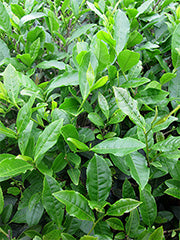 |
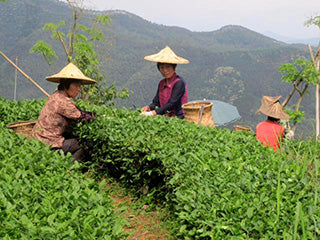
|
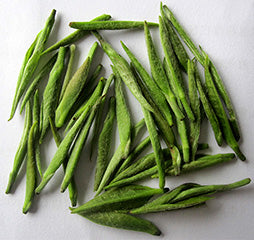
|
The leaves are dried under the sun
Just after picking them, the tea leaves are exposed to the sun to make a first drying. Not to burn the leaves with a too strong sun, producers regularly protect them with a net, as you can see in the picture below.
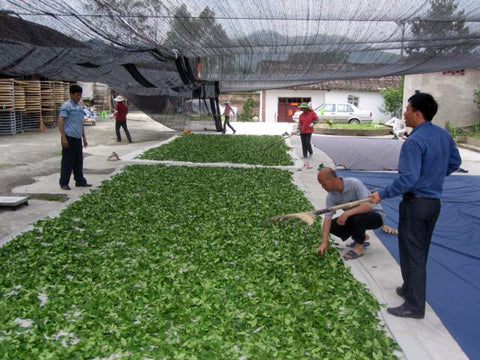
The tea leaves are dried indoors, on trays
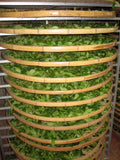
After spending a few hours in the sun, the leaves are spread on large willow trays. Drying will then continue from a few hours to a complete night. The leaves are then stored in a fairly well ventilated area protected from the sun.
The leaves are slightly broken to promote oxidation
 One major step in the manufacture of tea is the oxidation. This step mainly explains the tea flavours and its color.
One major step in the manufacture of tea is the oxidation. This step mainly explains the tea flavours and its color.
Oxidation occurs when the inner part of the leaf is in contact with air.
To promote such contact, it is necessary to break the leaf.
It is therefore easy to understand that the more you break the leaf and left it in contact with air, more the tea is oxidized. More the tea is oxidized, more it is black.
If the leaf is not broken and not in contact with air, it will not be oxidized. And we obtain white teas.
In the case of Oolong tea, oxidation depends on the producers ( from 15 % up to about 75%). In our case, oxidation is intermediate.
The leaves are dried in order to stop the oxidation
To stop the oxidation phenomenon, the tea leaves are then dried.

|

|
The leaves are then rolled and dried several times to give them their final form but also to permanently stop oxidation.
This operation can take place dozens of times. The photo below with the tea ball is specific to Oolong tea production. The steps for oolong tea production are slightly more numerous than in the case of a traditional teas.

|

|

|

|
The leaves are finally sorted to ensure quality
At the end of the process, the leaves are sorted but they can also be rolled manually to ensure a desired characteristic shape.
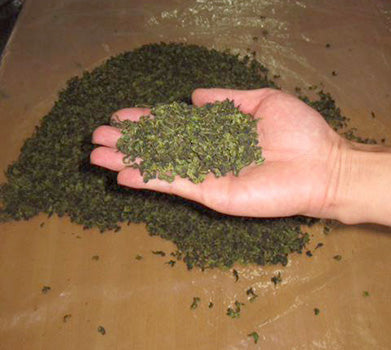
|
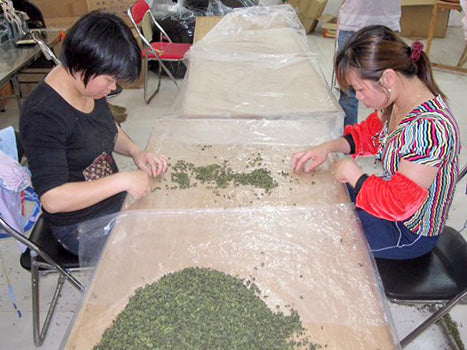
|
Oolong tea benefits
Oolong tea is particularly recognized in China but also in the rest of the world for its effects on digestion and for its ability to promote weight loss and thinness.
Oolong Tea : Taste and flavour
Oolong tea gives rise to a blue/green liqueur with very characteristic aromas and flavours.
It is a mild tea with flower aromas and sweet notes which can often remind caramel.
For your information, this tea is also quite low in caffeine.
Find Oolong tea in our
Detox teas Happy Detox Tea! As always, we want to offer you detox and slimming teas with taste and pleasant aromas. This is the main commitment of the Happy Detox Tea team.
For the record, note that the selected producer you can see in this article, is the one which tea had been selected to make a gift to Barack Obama during his last visit to China. It was then a Oolong Organic Fujian flavored with honey produced within the tea gardens. And I will not deny that it is excellent!
